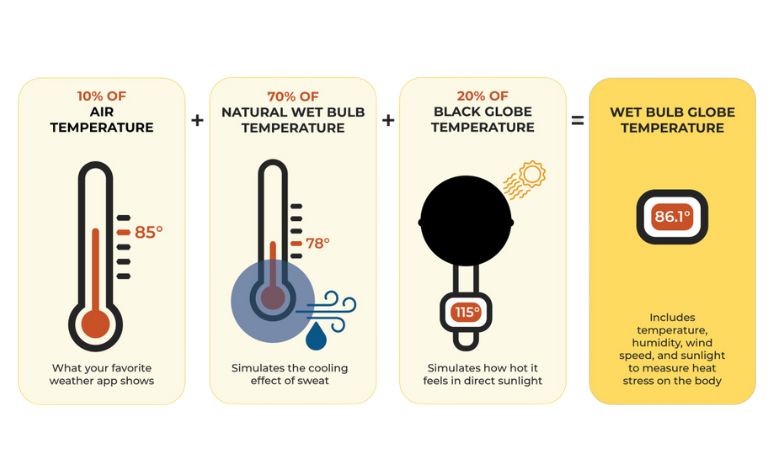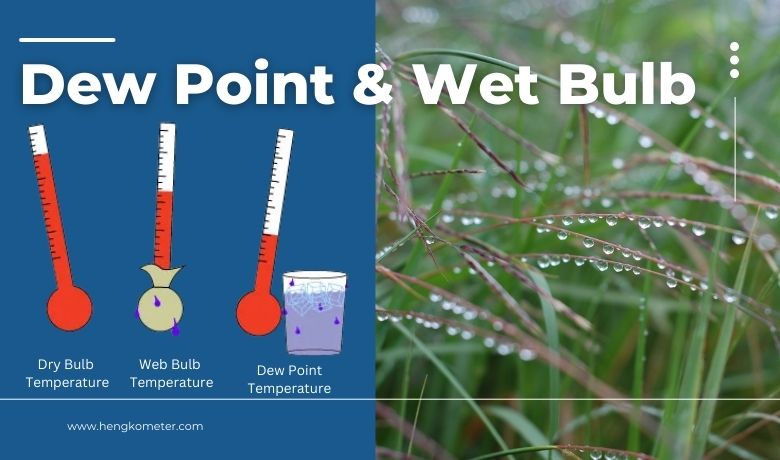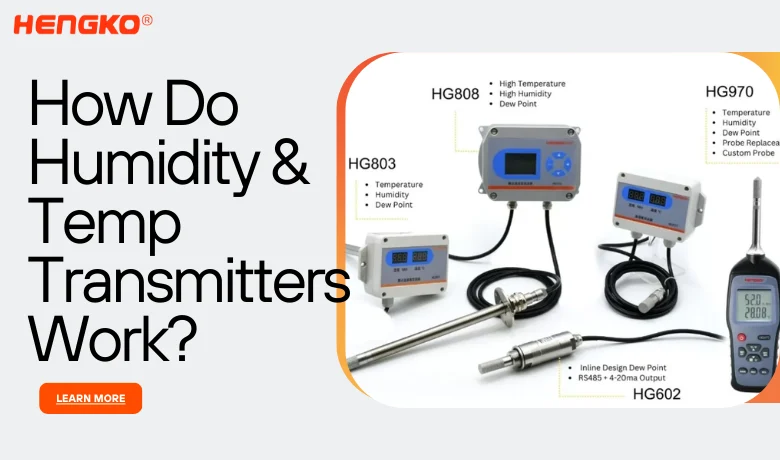Il punto di rugiada e la temperatura di bulbo umido sono due misure cruciali che forniscono indicazioni preziose sul contenuto di umidità dell'aria. Anche se possono sembrare termini tecnici, la comprensione del loro significato permette di ottenere una comprensione più profonda in diversi campi, tra cui:
- Previsioni meteorologiche: Queste misurazioni aiutano a prevedere fenomeni come la formazione di nebbia, le precipitazioni e i livelli di umidità, consentendo previsioni meteorologiche accurate.
- Agricoltura: Conoscere il punto di rugiada è fondamentale per gli agricoltori per valutare la salute delle colture e i potenziali rischi di malattie causate dall'eccessiva umidità.
- Sistemi HVAC: Il punto di rugiada e la temperatura di bulbo umido giocano un ruolo fondamentale nella progettazione e nel funzionamento di sistemi di condizionamento e deumidificazione efficienti.
- Comfort umano: Queste misure influenzano la percezione della temperatura. Un'umidità elevata combinata con una temperatura elevata può causare disagio, mentre la comprensione di questi fattori aiuta a creare ambienti interni confortevoli.
Ogni termine e il suo significato:
- Punto di rugiada: Immaginate di raffreddare l'aria a pressione costante. Il punto di rugiada è la temperatura alla quale il vapore acqueo presente nell'aria si condensa, formando rugiada o nebbia. Punti di rugiada più alti indicano una maggiore umidità nell'aria e conoscerli aiuta a prevedere la formazione di nebbia e le potenziali precipitazioni.
- Temperatura di bulbo umido: This temperature represents the lowest an air parcel can be cooled through evaporation. It’s measured using a thermometer wrapped in a wet cloth. As water evaporates from the cloth, it cools the thermometer, and the wet bulb temperature reflects the combined effect of air temperature and humidity.
Comprendendo la relazione tra queste misure e il loro impatto sui vari processi, otteniamo preziose informazioni sui modelli meteorologici, sulle pratiche agricole, sulla gestione efficiente degli edifici e persino sui nostri livelli di comfort.
Parte 1: Che cos'è il punto di rugiada?
Temperatura del punto di rugiada, in parole povere, è il “magic number” per l'umidità dell'aria. It’s the crucial temperature at which the air becomes saturo con il vapore acqueo, e inizia a formarsi la condensa, formazione di rugiada, nebbia, o gelo. Immaginate di lasciare una bevanda fredda all'aperto in una giornata umida; le gocce d'acqua si formano all'esterno quando la bevanda raggiunge la temperatura del punto di rugiada dell'aria circostante.
Il punto di rugiada è un indicatore chiave dell'umidità atmosferica. perché riflette direttamente la quantità di vapore acqueo che l'aria può contenere a una temperatura specifica. Punti di rugiada più alti indicano aria carica di umidità, mentre punti di rugiada più bassi indicano aria più secca.
La comprensione della relazione tra punto di rugiada e umidità dell'aria è essenziale:
- Umidità relativa: Questa percentuale esprime la quantità di umidità attualmente contenuta dall'aria rispetto alla sua capacità massima a quella temperatura. Quando il punto di rugiada e la temperatura dell'aria sono uguali, l'umidità relativa raggiunge 100%, a significare la saturazione e il potenziale di condensazione.
- Quando il punto di rugiada sale: Ciò indica che l'aria trattiene più umidità, anche se l'umidità relativa rimane costante. Questo scenario provoca spesso sensazioni di afa e disagio, soprattutto nelle giornate più calde.
Il punto di rugiada ha un impatto significativo sui modelli meteorologici e sul comfort umano in vari modi:
- Formazione di nebbia: Quando la temperatura dell'aria si raffredda fino al punto di rugiada durante la notte, il vapore acqueo si condensa, formazione di nebbia.
- Precipitazioni: L'aumento dei punti di rugiada può contribuire alla formazione di nubi e alle precipitazioni, influenzare le previsioni del tempo.
- Comfort umano: Gli alti punti di rugiada combinati con le alte temperature possono rendere l'aria afosa e fastidiosa, ostacolando la nostra capacità di sudare e di regolare la temperatura corporea. Al contrario, I bassi punti di rugiada, insieme alle temperature fredde, possono far sentire l'aria secca e frizzante.
Comprendendo il punto di rugiada, otteniamo preziose informazioni sui modelli meteorologici, anticipare i potenziali eventi meteorologici, e vestirsi in modo adeguato al livello di comfort percepito in base al tasso di umidità prevalente nell'aria.
Parte 2: Cos'è la temperatura di bulbo umido?
Temperatura di bulbo umido riflette il temperatura più bassa raggiungibile per evaporazione under specific atmospheric conditions. It’s measured using a special thermometer with a stoppino bagnato avvolto intorno al bulbo. Quando l'aria passa davanti allo stoppino, l'acqua evapora e il bulbo si raffredda. Il temperatura di bulbo umido è il temperatura di equilibrio raggiunto quando il tasso di guadagno di calore dall'aria è uguale al tasso di perdita di calore dovuto all'evaporazione.
L'importanza della temperatura di bulbo umido risiede nella sua capacità di rivelare l'efficacia dell'evaporazione nel raffreddare l'aria:
- Temperature di bulbo umido più elevate: Indicare potenziale di raffreddamento evaporativo limitato. Questo scenario si verifica spesso in ambienti ad alta umidità, dove l'aria è già satura di umidità, rendendo difficile l'evaporazione di ulteriore acqua.
- Temperature di bulbo umido più basse: Al contrario, significare maggiore potenziale di raffreddamento per evaporazione. Questo scenario si verifica tipicamente in ambienti più secchi, dove l'aria assorbe prontamente l'umidità dallo stoppino, determinando un raffreddamento più efficace.
La comprensione della temperatura di bulbo umido ha implicazioni reali per lo stress da calore e il comfort umano:
- Stress da calore: When both air temperature and wet bulb temperature are high, the body’s ability to cool down through sweating is hampered. This can lead to heat stress, exhaustion, and even heatstroke, especially during strenuous activities.
- Comfort umano: La temperatura di bulbo umido svolge un ruolo cruciale nel determinare la sensazione di benessere in un determinato ambiente. Anche in presenza di temperature moderate, un'elevata temperatura di bulbo umido può rendere l'aria umida e fastidiosa a causa del limitato effetto di raffreddamento per evaporazione.
Pertanto, il monitoraggio della temperatura di bulbo umido insieme alla temperatura dell'aria fornisce un quadro più completo dell'ambiente termico e del suo potenziale impatto sulla salute e sul comfort umano. Queste informazioni sono preziose per diverse applicazioni, tra cui:
- Sicurezza sul lavoro: Valutare i rischi di stress da calore per i lavoratori all'aperto e mettere in atto le opportune precauzioni.
- Preparazione atletica: Ottimizzazione delle condizioni di allenamento per prevenire le malattie da calore negli atleti.
- Progettazione e gestione degli edifici: Progettazione e gestione di impianti di climatizzazione che gestiscono efficacemente temperatura e umidità per un comfort ottimale.
Comprendendo il concetto di temperatura di bulbo umido, si comprende meglio la complessa interazione tra temperatura e umidità e la loro influenza combinata sul nostro benessere e sull'ambiente circostante.

Parte 3: Punto di rugiada e temperatura di bulbo umido: le differenze
Mentre sia il punto di rugiada che la temperatura di bulbo umido offrono preziose indicazioni sull'umidità dell'aria, rappresentano concetti distinti con implicazioni uniche:
Differenze chiave:
| Caratteristica | Punto di rugiada | Temperatura di bulbo umido |
|---|---|---|
| Definizione | Temperatura a cui l'aria diventa satura e si verifica la condensazione | La più bassa temperatura raggiungibile per evaporazione in condizioni specifiche |
| Misurazione | Indirectly calculated from temperature and humidity | Measured using a thermometer with a wetted wick |
| Indication | Absolute moisture content in the air | Evaporative cooling potential of the air |
| Impact on Weather | Influences fog formation, precipitation | No direct impact, but indirectly affects heat index |
| Impact on Comfort | High dew point = muggy feeling, low dew point = dry feeling | High wet bulb temperature = limited cooling, low wet bulb temperature = effective cooling |
Relationship to Air Moisture:
Both dew point and wet bulb temperature are indirectly related to the absolute amount of moisture in the air. However, they capture different aspects of this moisture:
- Punto di rugiada: Reflects the maximum amount of moisture the air can hold at a specific temperature before condensation occurs. Higher dew points indicate more moisture-laden air.
- Temperatura di bulbo umido: Doesn’t directly measure moisture content but indicates how readily the air can absorb additional moisture through evaporation. Lower wet bulb temperatures suggest drier air with greater capacity for evaporation.
Visualizing the Relationship:
A psychrometric chart effectively illustrates the relationship between dew point, wet bulb temperature, and relative humidity:
On the chart:
- Diagonal lines: Represent lines of constant wet bulb temperature.
- Vertical lines: Represent lines of constant dew point.
- Curves: Represent lines of constant relative humidity.
Interpreting the chart:
- A point on the chart represents the current state of the air based on its dry bulb temperature, wet bulb temperature, and relative humidity.
- Following a horizontal line from the dew point value indicates the corresponding relative humidity.
- Following a vertical line from the wet bulb temperature value indicates the corresponding relative humidity.
Understanding these relationships is crucial for interpreting weather forecasts and predicting human comfort levels. For example, a high dew point combined with a high wet bulb temperature suggests very humid air with limited evaporative cooling potential, leading to a feeling of mugginess and discomfort.
By appreciating the distinct roles of dew point and wet bulb temperature, we gain a more comprehensive understanding of the interplay between temperature, humidity, and their combined impact on various aspects of our lives.
Part 4: Applications
Understanding dew point and wet bulb temperature extends beyond theoretical knowledge; they play crucial roles in various practical applications:
Weather Forecasting:
- Predicting fog formation: High dew points combined with falling temperatures indicate a higher likelihood of fog formation at night.
- Assessing precipitation potential: L'aumento dei punti di rugiada può contribuire alla formazione di nubi e alle precipitazioni, aiding in more accurate weather forecasts.
- Calculating heat index: Wet bulb temperature is incorporated into the heat index calculation, which reflects how hot it actually feels due to the combined effects of air temperature and humidity. This information is crucial for issuing heat advisories and warnings.
Agricoltura:
- Optimizing irrigation: Knowing the dew point helps farmers assess the need for irrigation by considering the existing moisture content in the air. Higher dew points suggest less moisture is lost through evaporation, potentially reducing irrigation requirements.
- Protecting crops from frost: Monitoring dew point allows farmers to anticipate frost events and take preventative measures to protect their crops, such as using frost protection techniques.
Sistemi HVAC:
- Progettazione di sistemi di climatizzazione efficienti: Dew point plays a vital role in designing air conditioning systems. By considering the dew point, engineers can determine the appropriate cooling capacity and dehumidification capabilities needed to maintain comfortable indoor conditions.
- Optimizing building energy efficiency: Understanding the relationship between dew point and wet bulb temperature allows for optimizing air conditioning and heating systems to achieve desired comfort levels while minimizing energy consumption.
Public Health:
- Preventing heat-related illnesses: Wet bulb temperature plays a crucial role in assessing heat stress risks. High wet bulb temperatures combined with high air temperatures can significantly limit the body’s ability to cool down, increasing the risk of heatstroke and other heat-related illnesses. Public health advisories and recommendations are often issued based on heat index calculations that incorporate wet bulb temperature.
By understanding the practical applications of dew point and wet bulb temperature, we can appreciate their significant impact on various aspects of our lives. From weather forecasting and agricultural practices to ensuring comfortable living environments and safeguarding public health, these measurements play a vital role in making informed decisions and promoting well-being.
Part 5: Measuring Dew Point and Wet Bulb Temperature
Understanding dew point and wet bulb temperature is valuable, but their practical application requires knowing how to measure them. Here, we explore the tools and methods used:
Measuring Dew Point:
- Direct measurement: Electronic hygrometers directly measure dew point using a chilled mirror or sensor that detects the temperature at which condensation occurs.
- Indirect measurement: This method involves measuring dry bulb temperature and relative humidity using a psychrometer or combination instrument. Dew point can then be calculated using various formulas or psychrometric charts.
Measuring Wet Bulb Temperature:
- Psicrometro a fionda: This traditional instrument consists of two thermometers, one dry and one with a wick saturated with water. By whirling the psychrometer, air flows over the wet bulb, causing evaporation and lowering its temperature. The difference between the dry and wet bulb temperatures is used to calculate the wet bulb temperature using psychrometric tables or charts.
- Assmann psychrometer: This more advanced instrument uses forced ventilation to achieve a more accurate and consistent measurement of the wet bulb temperature.
- Electronic psychrometers: These instruments combine electronic sensors to measure dry bulb temperature, humidity, and sometimes directly calculate wet bulb temperature.
Psychrometric Chart:
The psychrometric chart is a graphical tool that helps determine dew point and wet bulb temperature from other known parameters like dry bulb temperature and relative humidity. It consists of a series of curves and lines representing various combinations of these variables.
Using the Psychrometric Chart:
- Locate the point on the chart corresponding to the measured dry bulb temperature on the horizontal axis.
- Follow a vertical line upwards from this point until it intersects the curve representing the measured relative humidity.
- The dew point can be found by following a horizontal line from the intersection point towards the left axis.
- The wet bulb temperature can be found by following a diagonal line downwards from the intersection point towards the left axis.
Benefits of the Psychrometric Chart:
- Provides a visual representation of the relationships between dry bulb temperature, wet bulb temperature, dew point, and relative humidity.
- Allows for quick estimation of dew point and wet bulb temperature from readily available measurements.
- Offers valuable insights into the thermodynamic properties of air for various applications.
By understanding the tools and techniques for measuring dew point and wet bulb temperature, along with the utility of the psychrometric chart, individuals can gain valuable insights into the moisture content of the air and its implications for various aspects of their lives.
Part 6: FAQ.
Q: Why do dew point and wet bulb temperature matter?
A: These measurements offer valuable insights into the moisture content of the air, impacting various aspects of our lives:
- Previsioni meteorologiche: They play a crucial role in predicting fog formation, precipitation potential, and heat index, leading to more accurate forecasts.
- Agricoltura: Understanding these helps farmers optimize irrigation needs, protect crops from frost, and assess crop health.
- Sistemi HVAC: They are essential for designing efficient air conditioning and heating systems, ensuring comfort and minimizing energy consumption.
- Public health: Wet bulb temperature is crucial for assessing heat stress risks and preventing heat-related illnesses.
Q: How do they affect weather forecasts?
A: Dew point and wet bulb temperature influence weather forecasts in several ways:
- Punto di rugiada: High dew points indicate higher moisture content, increasing the likelihood of fog formation at night and contributing to cloud formation and potential precipitation.
- Temperatura di bulbo umido: It is incorporated into the heat index calculation, reflecting how hot it feels due to the combined effects of air temperature and humidity. This information is crucial for issuing heat advisories and warnings.
Q: What are the safety thresholds for human health?
A: Wet bulb temperature plays a significant role in assessing heat stress risks. While there’s no single universal threshold, the National Oceanic and Atmospheric Administration (NOAA) considers the following:
- Moderate risk: Wet bulb temperature of 64-74°F (17.8-23.3°C)
- High risk: Wet bulb temperature of 74-79°F (23.3-26.1°C)
- Extreme risk: Wet bulb temperature above 79°F (26.1°C)
These thresholds can vary depending on factors like age, health conditions, and acclimatization. It’s crucial to stay informed about heat advisories and take necessary precautions to avoid heat-related illnesses, especially during periods with high wet bulb temperatures.
Conclusione
Throughout this exploration, we have delved into the fascinating world of dew point and wet bulb temperature, uncovering their distinct roles in understanding the moisture content of air and its impact on various aspects of our lives.
Key Takeaways:
- Punto di rugiada: Reflects the “tipping point” for moisture in the air, indicating when condensation occurs and influencing weather patterns like fog formation and precipitation.
- Temperatura di bulbo umido: Represents the lowest achievable temperature through evaporation, providing insights into the evaporative cooling potential of the air and impacting human comfort levels.
Understanding the differences between these two measurements is crucial for:
- Interpreting weather forecasts: Predicting potential for fog, precipitation, and heat stress.
- Optimizing agricultural practices: Managing irrigation needs and protecting crops from frost damage.
- Designing efficient HVAC systems: Ensuring comfort and minimizing energy consumption in buildings.
- Safeguarding public health: Assessing heat stress risks and preventing heat-related illnesses.
Moving forward, consider monitoring these measurements:
- Weather forecasts: Stay informed about dew point and heat index values to plan outdoor activities accordingly.
- Personal comfort: Utilize dew point and wet bulb temperature readings to adjust thermostat settings and clothing choices for optimal comfort.
- Professional applications: For those involved in weather forecasting, agriculture, or HVAC system design, a deeper understanding of these measurements is essential for informed decision-making.
By appreciating the significance of dew point and wet bulb temperature, we gain valuable knowledge that empowers us to navigate the complexities of our environment, ensuring optimal comfort, efficient resource management, and ultimately, a deeper appreciation for the intricate interplay between moisture and the world around us.






